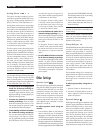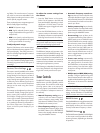
27
English
Overview of
Surround Formats
To get the best performance from your
RSX-1057, it helps to understand the many
surround sound formats available today, to
know which decoding process to use for a
particular recording, and how to select it. This
section provides basic background informa
-
tion about surround sound formats. The fol
-
lowing sections provide detailed operating
instructions for automatic and manual selec-
tion of surround modes.
NOTE: The RSX-1057 has built-in amplifiers to
drive five speakers in a 5.1 channel system.
To use surround modes for 6.1 or 7.1 chan-
nel systems, you will need a separate power
amplifier to drive one or two speakers.
Dolby Surround
Dolby Pro Logic II
The most widely available surround sound
format for consumer audio/video is Dolby
Surround
®
, available on nearly all commer-
cial VHS tapes, many television broadcasts,
and most DVDs. Dolby Surround is the con-
sumer version of the analog Dolby Stereo
system first introduced in the film industry in
1972. It is a matrix-encoding system that re
-
cords front left, front center, front right, and
a mono surround channel into a 2-channel
stereo recording. During playback, a Dolby
Pro Logic
®
or Pro Logic II decoder extracts
each channel and distributes it to the appro
-
priate speakers.
The original Dolby Pro Logic decoder delivered
a mono signal with reduced high-frequency
content to the surround speakers. A more
advanced decoder in the RSX-1057, Dolby
Pro Logic II, increases the separation and
frequency response of the surround channels
for significantly improved performance with
Dolby Surround encoded recordings.
Dolby Pro Logic II decoding should be used
for any analog recording labeled “Dolby Sur
-
round” or any Dolby Digital 2.0 soundtrack.
Dolby Pro Logic II does a superb job deriving
surround sound from conventional 2-channel
stereo recordings, using phase relationships
to extract front, right, center, and surround
channels. A “music mode” makes Pro Logic
II an excellent choice for audio CDs.
Dolby Digital
In 1992, a digital recording system, called
Dolby Digital, was first used in the film indus
-
try. Dolby Digital is a recording/playback
system that uses compression techniques to
store large amounts of audio data efficiently,
much like the JPEG format stores large pho
-
tographs in small files on a computer. Be
-
cause it is capable of performance beyond
that of audio CDs and can tailor its output
for a wide ranges of system configurations,
Dolby Digital is the standard audio format for
DVDs and for digital television broadcasting
in the United States.
The Dolby Digital system can be used to re
-
cord up to six discrete audio channels, but
can also be used for fewer. For example, a
Dolby Digital 2.0 soundtrack is a digital 2-
channel recording of a matrix encoded Dol
-
by Surround soundtrack.. To play a Dolby
Digital 2.0 recording, use Dolby Pro Logic II
decoding as previously described.
The most common use of Dolby Digital in
newer films, in both the film industry and in
home theater, is Dolby Digital 5.1. Instead
of encoding multiple surround channels on
a two-channel recording, Dolby Digital 5.1
records six discrete channels: front left, front
center, front right, surround left, surround right,
and a Low Frequency Effects (LFE) channel
containing ultra-low bass signals intended
for a subwoofer. A Dolby Digital decoder
extracts the channels from the digital bit
-
stream, converts them to analog signals and
routes them to the appropriate amplifiers and
speakers. All channels provide full frequency
response with total separation between all
channels and large dynamic range capabil
-
ity. A Dolby Digital 5.1 soundtrack can pro
-
vide more impressive surround sound than
matrix Dolby Surround.
Decoding of Dolby Digital 5.1 soundtracks
is automatic. When the RSX-1057 detects a
Dolby 5.1 signal on one of its digital inputs,
it activates the proper processing. Keep in
mind that Dolby Digital is only available
from digital sources (a DVD, a LaserDisc, or
a Digital TV/Cable/SAT tuner). Also, you
must connect the source with a digital cable
(coax or optical) to an active digital input
on the RSX-1057.
NOTE: Many DVDs have a Dolby Digital 2.0
matrix soundtrack as the default, which should
be decoded with Pro Logic II. The Dolby Digital
5.1 soundtrack may have to be selected as an
option from the setup menus at the beginning
of the DVD. Look for a Dolby Digital 5.1 selec
-
tion under “Audio” or “Languages” or “Setup
Options” when you insert the disc.
DTS
5.1
DTS 96/24
DTS
®
(Digital Theater Systems) is an alterna-
tive digital format competing with Dolby Digi
-
tal in both movie theaters and home theater
markets. The basic functions of the DTS sys-
tem are similar to those of Dolby Digital (for
example, 5.1 discrete channels), however
the technical details of the compression and
decoding processes differ somewhat and a
DTS decoder is required.
A recent extension of the DTS encoding sys-
tem is DTS 96/24. These recordings provide
the performance of a 96kHz sampling rate
while still using actual 48kHz sampling rate
of standard DTS discs.
Like Dolby Digital, DTS can only be used on a
digital recording and, therefore, is only avail-
able for home use on LaserDiscs, DVDs, or
other digital formats. To use the RSX-1057’s
DTS decoder, you must connect your DVD
player to the RSX-1057’s digital inputs.
As with Dolby Digital 5.1, detection and proper
decoding of DTS 5.1 signals is automatic.
NOTE: DVDs with a DTS soundtrack almost al-
ways have it configured as an option to the
standard matrix Dolby Surround format. To use
DTS, you may have to go to the setup menus
at the beginning of the DVD and select “DTS
5.1” instead of “Dolby Surround” or “Dolby
Digital 5.1”. In addition, many DVD players
have the DTS digital bitstream turned off by
default and cannot output a DTS soundtrack
(even if selected on the disc’s menu) until you
activate the player’s DTS output. If you hear
no sound the first time you attempt to play a
DTS disc, go to the DVD player’s configura
-
tion menus and turn on the DTS bitstream.
This is a one-time setting and need only be
done once.


















